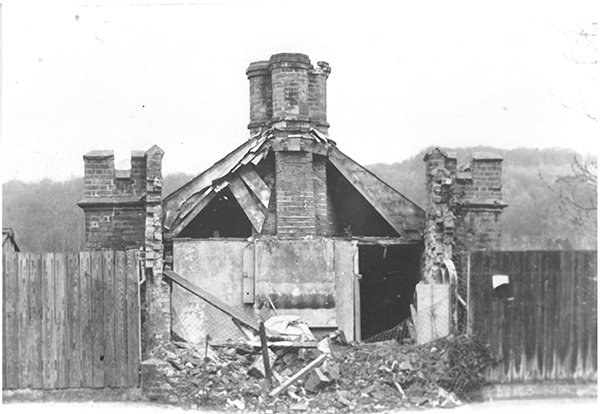The History of Our Toll House
The toll house at Chiltern Open Air Museum
Between 1724 and 1727 Daniel Defoe, author of Robinson Crusoe, published A tour through the whole island of Great Britain. He comments that the roads all over the country “had been ploughed so deep, and materials have been in some places so difficult to be had for repair of the roads, that all the surveyors rates have been able to do nothing”. The problem was that until the 16th century wheeled vehicles were quite rare, but thereafter more and more goods and people were being transported around the country, rendering the roads, which were simply unsurfaced paths that had grown up over centuries, impossible to maintain.
Very early in the 13th and 14th centuries a few roads such as busy streets in London charged a toll (for example in 1346 tolls were collected for what is now Aldersgate Street), but generally it was the people of each parish throughout the country who were responsible for repairing the roads, a completely untenable situation. Therefore in 1663 an Act of Parliament was passed which established Turnpike Trusts empowered to set up gates and to collect tolls which were spent on the upkeep of the roads.In 1718 the Beaconsfield to Stokenchurch Trust was set up of which COAM’s Toll House was a part. This in turn was part of the main London to Oxford road. Apart from general traffic the main roads from London also carried the Stagecoaches, the long-distance transport of the time. Stagecoaches passing through our Toll were travelling to London from Birmingham, Cheltenham, Gloucester, Hereford, Warwick, Worcester and Wantage.
In 1840 there were 22,000 miles of turnpike roads in England and Wales with 3,000 coaches running regular services employing 30,000 men, 150,000 horses and 20,000 toll keepers who collected £1,500,000 each year which is roughly £90,000,000 in today’s money. Four horses could pull a coach at 10 miles an hour for one hour (i.e. a stage), hence coaching inns were about 10 miles apart. Alan Bell’s Directory of Stage Services, 1836 shows that the first coach of the day through our Toll was The Union coach at 1.15 am and the last The Royal Mail at 2315 pm. These coaches often had splendid names such as The Retaliator, The Regulator, The Champion and The Good Intent. In total there were 28 coaches on the timetable, but in addition there would be local traffic, untimed services and general rural traffic.
The restored kitchen of the toll house at the museum
Many Toll Houses were far less imposing than the High Wycombe Toll House. This is because COAM’s Toll House was built very close to Wycombe Abbey. The owner Robert Smith, the first Lord Carrington, employed James Wyatt to refashion Loakes Manor which he had bought in 1798 into the then popular neo-Gothic style. In order to blend in with the newly renovated and re-named Wycombe Abbey, the Toll House was built in a similar style. The Toll House remained active until 1867 by which time the coming of the railways resulted in coach traffic becoming less and less until in 1867 tolls ceased to be collected.
The coming of the railways spelt disaster for most turnpike trusts. Although some trusts in districts not served by railways managed to increase revenue, most did not. For example, in 1830, the year when the Liverpool and Manchester Railway opened, the Warrington and Lower Irlam Trust had receipts of £1,680 but, by 1834, this had fallen to £332.
When our Toll House became obsolete it was first used as an ordinary house, then by the groundsmen of the Cricket Ground, then as a chair making workshop and between 1939 to 1945 as an A.R.P. Warden’s post. In 1972 a lorry collided with it, demolishing the front room. Thereafter it was removed to the Museum.
Our toll house in 1974 before it came to the museum
Gatekeepers were usually paid between five and seven shillings a week (more in London), but this low wage was usually offset by a rent-free house, often supplied with free candles and fuel. However, gatekeeping was particularly vulnerable to fraud, such as overcharging travellers, failing to account for the tolls, and taking bribes not to weigh vehicles where a weighing machine was in use. Leasing gates for a fixed sum was popular, although even this was no guarantee against fraud. Trusts were obliged by law to auction the lease of a gate, with the starting bid being equivalent to the sum it produced in the preceding year. Therefore, if the gatekeeper who was eligible to bid for the lease on a gate withheld receipts to decrease the gate’s income, its rental value was lowered, while those attending the auction could fix the bidding between themselves in advance.
Gatekeepers were of course unpopular and frequently suffered violence at the hands of travellers. They also had access to relatively large amounts of money, hence the bars on the windows of our toll house. They lived with their families in the toll house, and we know that in 1841 Thomas Brickwell lived in our toll house with his wife, Margaret and their three children, Mary Ann 11, James 9 and Martha 6.In all our minds there are memories of films depicting cheerful, ruddy-faced passengers enjoying their coach ride.
Thomas Cooper, a poet and leading Chartist whose life (1805-1892) spanned the change from coach to railway, presents us with a different view!“Oh, for the dear old coach again!” I cry ―But soon remind myself o’ the pelting rain,And that umbrella which the old man would tryTo hold up still for shelter, with insaneResolve, although it drenched our necks; the painOf sitting, crampt, for lack of room; the windThat kept us in one posture, like a chain ―It was so keen! And then I am inclinedTo own ’twas well men did the steam-steed find, and bind!
Written by Roger Coode, Museum Volunteer



